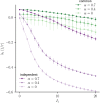Input correlations impede suppression of chaos and learning in balanced firing-rate networks
- PMID: 36469504
- PMCID: PMC9754616
- DOI: 10.1371/journal.pcbi.1010590
Input correlations impede suppression of chaos and learning in balanced firing-rate networks
Abstract
Neural circuits exhibit complex activity patterns, both spontaneously and evoked by external stimuli. Information encoding and learning in neural circuits depend on how well time-varying stimuli can control spontaneous network activity. We show that in firing-rate networks in the balanced state, external control of recurrent dynamics, i.e., the suppression of internally-generated chaotic variability, strongly depends on correlations in the input. A distinctive feature of balanced networks is that, because common external input is dynamically canceled by recurrent feedback, it is far more difficult to suppress chaos with common input into each neuron than through independent input. To study this phenomenon, we develop a non-stationary dynamic mean-field theory for driven networks. The theory explains how the activity statistics and the largest Lyapunov exponent depend on the frequency and amplitude of the input, recurrent coupling strength, and network size, for both common and independent input. We further show that uncorrelated inputs facilitate learning in balanced networks.
Copyright: © 2022 Engelken et al. This is an open access article distributed under the terms of the Creative Commons Attribution License, which permits unrestricted use, distribution, and reproduction in any medium, provided the original author and source are credited.
Conflict of interest statement
The authors have declared that no competing interests exist.
Figures










Similar articles
-
Stimulus-dependent suppression of chaos in recurrent neural networks.Phys Rev E Stat Nonlin Soft Matter Phys. 2010 Jul;82(1 Pt 1):011903. doi: 10.1103/PhysRevE.82.011903. Epub 2010 Jul 7. Phys Rev E Stat Nonlin Soft Matter Phys. 2010. PMID: 20866644 Free PMC article.
-
Transitions between asynchronous and synchronous states: a theory of correlations in small neural circuits.J Comput Neurosci. 2018 Feb;44(1):25-43. doi: 10.1007/s10827-017-0667-3. Epub 2017 Nov 10. J Comput Neurosci. 2018. PMID: 29124505 Free PMC article.
-
Comparison of the dynamics of neural interactions between current-based and conductance-based integrate-and-fire recurrent networks.Front Neural Circuits. 2014 Mar 5;8:12. doi: 10.3389/fncir.2014.00012. eCollection 2014. Front Neural Circuits. 2014. PMID: 24634645 Free PMC article.
-
Chaotic recurrent neural networks for brain modelling: A review.Neural Netw. 2025 Apr;184:107079. doi: 10.1016/j.neunet.2024.107079. Epub 2024 Dec 27. Neural Netw. 2025. PMID: 39756119 Review.
-
Once upon a (slow) time in the land of recurrent neuronal networks….Curr Opin Neurobiol. 2017 Oct;46:31-38. doi: 10.1016/j.conb.2017.07.003. Epub 2017 Jul 27. Curr Opin Neurobiol. 2017. PMID: 28756341 Free PMC article. Review.
Cited by
-
Desegregation of neuronal predictive processing.bioRxiv [Preprint]. 2024 Aug 7:2024.08.05.606684. doi: 10.1101/2024.08.05.606684. bioRxiv. 2024. PMID: 39149380 Free PMC article. Preprint.
-
Balanced state of networks of winner-take-all units.PLoS Comput Biol. 2025 Jun 11;21(6):e1013081. doi: 10.1371/journal.pcbi.1013081. eCollection 2025 Jun. PLoS Comput Biol. 2025. PMID: 40498862 Free PMC article.
-
Exploring Flip Flop memories and beyond: training Recurrent Neural Networks with key insights.Front Syst Neurosci. 2024 Mar 27;18:1269190. doi: 10.3389/fnsys.2024.1269190. eCollection 2024. Front Syst Neurosci. 2024. PMID: 38600907 Free PMC article.
-
Multitasking via baseline control in recurrent neural networks.Proc Natl Acad Sci U S A. 2023 Aug 15;120(33):e2304394120. doi: 10.1073/pnas.2304394120. Epub 2023 Aug 7. Proc Natl Acad Sci U S A. 2023. PMID: 37549275 Free PMC article.
References
-
- Schuecker J, Goedeke S, Helias M. Optimal Sequence Memory in Driven Random Networks. Physical Review X. 2018;8(4):041029. doi: 10.1103/PhysRevX.8.041029 - DOI
Publication types
MeSH terms
Grants and funding
LinkOut - more resources
Full Text Sources

